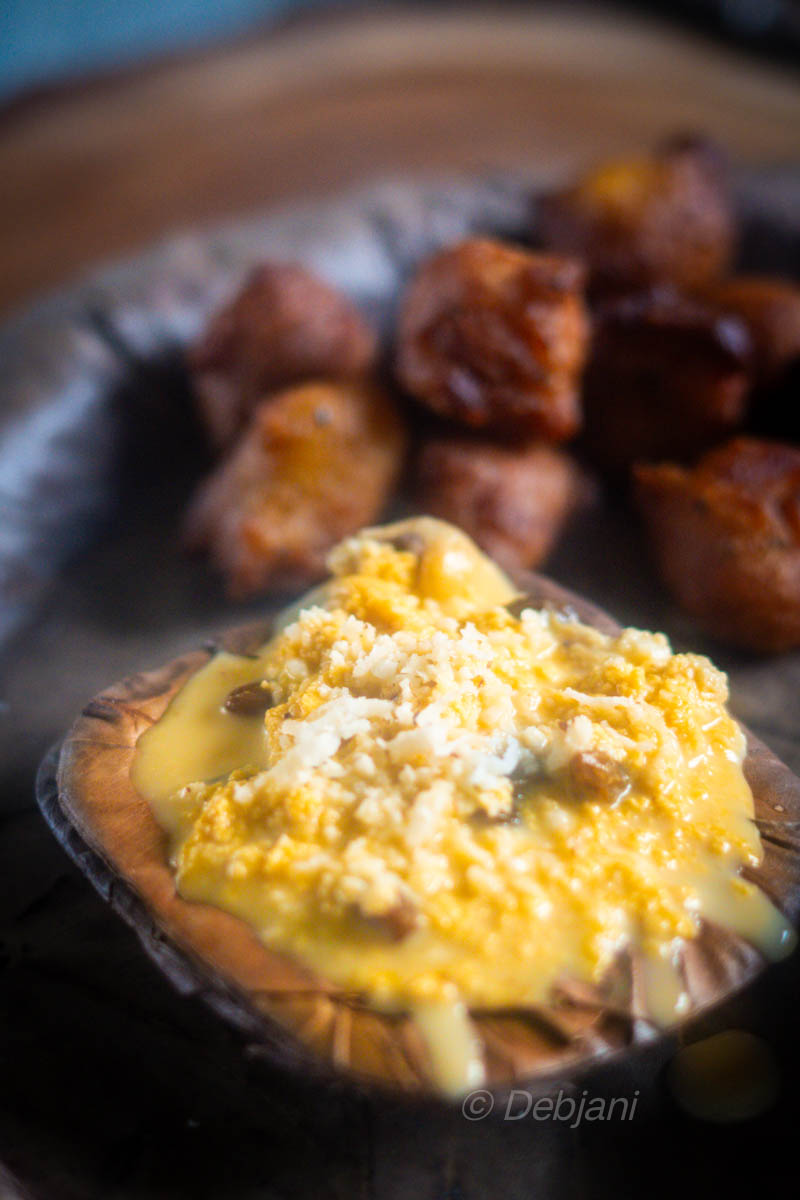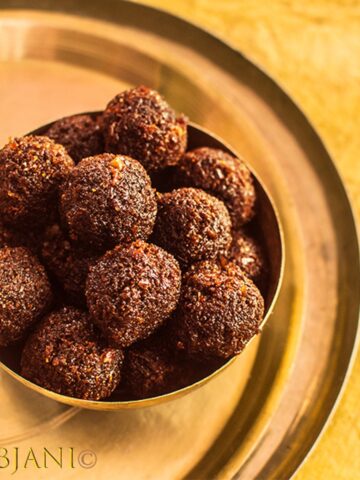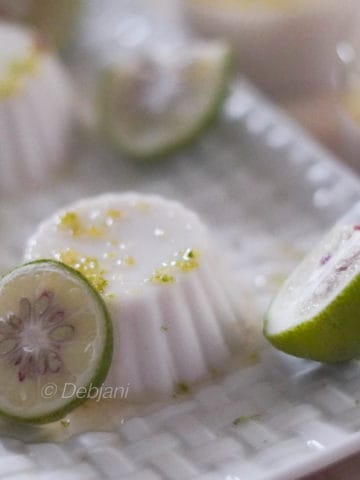Taal Kheer, or Taaler Payesh, is a popular dessert in Bengal that is made during certain times of the year viz August to October. It is made using sugar palm extract, coconut, milk, and various nuts such as cashews, almonds, and raisins. I personally like to use jaggery to sweeten this dessert, but sugar can also be used.

Although Taler Bora is the most well-known dessert made with Taal extract, also known as Sugar Palm extract, Taal Kheer is just as delicious. However, I believe that it all comes down to personal taste. Taaler Payesh, a type of pudding, prepared with Palmora pulp, is bursting with the strong flavor and aroma of sugar palm, which is quite distinct from the subtle flavors found in most traditional payesh or kheer.
Jump to:
- Taal Kheer Background Notes from Debjanir Rannaghar
- Taal Kheer Ingredients
- Substitutions
- Variations
- Top tip - Extracting Sugar Palm Pulp aka Taal Rash
- Equipment
- Storing Taal Kheer
- Frequently Asked Questions
- Recipe Card
- Related Recipes
- Pairing food for Janmashtami
- Have you tried the Taaler Payesh aka Taal Kheer recipe from Debjanir Rannaghar!
- Here's the Taal Kheer Pin for your Pinterest Board!
Taal Kheer Background Notes from Debjanir Rannaghar
In Bengal, Janmashtami and Taal are connected. During these occasions, we make special sweets using Taal. I wrote a recipe for Taler Bora a while ago, which has an amusing story attached to it. In addition, you can find other recipes such as Taler Patishapta, Taler Luchi, or Taler Bibikhana Pitha also here on the blog. Sugar palms are frequently used during Janmashtami to make different delicacies in Hindu households, while Muslim households use Taal to create various pitha. However, Sugar Palm is a seasonal fruit and it requires effort to extract the pulp from ripe and soft sugar palm.

Taal Kheer Ingredients
Taaler Payesh, also known as Taal Kheer is a delightful and aromatic dessert. It is a seasonal favorite of many in Bengal. We made This dessert is made with the extract of sugar palm along with fresh coconut, milk, and an assortment of nuts, including cashew nuts, almonds, raisins, and also milk. The unique combination of flavors and textures in this dish is what makes it a must-try for anyone who loves sweets.
One of the things that makes Taal Kheer so special is the use of jaggery to sweeten the dish. Jaggery is a type of unrefined sugar that is made from sugarcane juice. It has a distinct flavor that is both earthy and sweet. This sweetness pairs perfectly with the rich and creamy coconut milk, and the crunch of the nuts adds a satisfying texture to the dish.

See the recipe card for quantities.
Substitutions
If you want to add a more refined taste to your taal kheer, you can use sugar instead of jaggery. However, jaggery gives the dish a natural, earthy flavor and adds depth to the delicate taste. To make a vegan version of Taaler Payesh, you can replace the milk with coconut milk. You must also substitute jaggery with coconut sugar. If you want to make Taaler Payesh more creamy and rich, add evaporated milk, condensed milk, or Khoa to the recipe.
Variations
There are many variations of Taal Kheer. Each region of Bengal has its own unique take on this classic dessert. Some recipes call for the addition of saffron or cardamom, which adds a warm and fragrant aroma to the dish. Others may use condensed milk or evaporated milk to give the dish a thicker and creamier texture.

Regardless of the recipe, Taal Kheer is a dessert that is sure to delight your taste buds. It will leave you feeling satisfied. Whether you are enjoying it after a hearty meal or as a sweet treat in the months of August - October, this dish is the perfect way to indulge your sweet tooth. So try this dessert and experience the rich flavors of Bengali cuisine.
Top tip - Extracting Sugar Palm Pulp aka Taal Rash
The Sugar Palm fruit is only available during certain times of the year. It can be quite a challenge to collect the ripe and soft Sugar Palm pulp for extraction. I learned a useful technique for managing Taal from the matriarch of my family. My grandmother, Dida, also did this, but more frequently. I now wait for my mother to visit or for a free Sunday to make my own pulping attempts. However, I also learned a new technique from my former housekeeper, Chandana, for extracting Sugar Palm pulp. I even recorded the process and created a video showcasing four different recipes using Taal. If you're interested, check out my video!
Equipment
The tools you use can greatly affect the outcome of a recipe, especially when dealing with ingredients like fruit and milk. It's recommended to use sturdy, clean utensils when preparing dishes such as kheer or Payesh.
Storing Taal Kheer
Typically, I take out the pulp and cook it on the stove until it reduces in volume. Afterward, I store it in the fridge and use it to create tasty treats. However, for Taal Kheer, we make sure to consume it within 48 hours of preparing it. After that, I store it in the fridge to keep it fresh.
Frequently Asked Questions
Toddy Palm, Palmyra, and Taal are all names for the Sugar Palm.
Taal is abundant in essential nutrients like iron, zinc, potassium, and calcium. Likewise, sugar palm is a great source of minerals and vitamins B and C. Furthermore, Taal is a fibrous fruit that promotes digestive health.
The most difficult aspect of working with Tal is extracting the pulp. Traditionally, a Bamboo Basket called Bet-er Jhuri is used to scrape the fruit to extract the pulp. In my experience, using a normal grater is much easier than the basket. However, my housekeeper, Chandana, taught me a new trick. She used the sharp edge of a stainless steel milk container to extract the pulp. Check out the video below for a demonstration.
Recipe Card

Taal Kheer | Taaler Payesh | Sugar Palm Pudding
- Total Time: 1 hour
- Yield: 4 People 1x
- Diet: Vegetarian
Description
Taal Kheer, also known as Taaler Payesh, is a well-liked sweet dish in Bengal that includes ingredients like sugar palm extract, coconut, milk, jaggery, and a mixture of nuts like cashews, almonds, and raisins.
Ingredients
- 1 Sugar Palm
- 150g Sugarcane Jaggery/ Aakher gur
- 1 Coconut
- 300ml Milk
- 25g Cashewnuts
- 25g Raisin
Instructions
Prep Work
- Scrap the coconut and keep it aside.
Extracting Sugar Palm Juice
- First, remove the crown of the sugar palm and get rid of the fibrous skin.
- Then, separate the sugar palm from the mid. This should be an easy task and you'll end up with 2 or 3 seeds covered in pulpy fibrous fruit.
- Sprinkle some water onto a seed and then use a basket, grater, edgy container, to grate the fruit.
- During this process, you can sprinkle water every now and then.
- The fruit pulp will separate easily from the seed while grating.
- Once done, strain the pulp to remove the fiber (See notes).
Making Sugar Palm Reduction
- When using Tal Rash in a recipe, it's important to have sugar palm reduction.
- I recommend making a large batch so that it can be stored for multiple uses and can enhance different dishes.
- Additionally, the reduction can counteract the bitterness of palmora juice.
- Begin by cooking the tal rash over a low flame for approximately 5-6 minutes.
- Continuously stir the mixture and turn off the flame once it is finished. Afterward, take 3 cups of this reduction to prepare Taal Kheer.
Making Taler Payesh aka Taal Kheer
- Another interesting tip is to use a portion of the Taal Kheer to make the filling for Taal Patishapta, as I have previously shared the recipe for it.
- This process is like a chain reaction or a relay race, where one fruit can be utilized to create various delicious dishes. Although it may seem complicated, it is an innovative way to make the most out of a single ingredient.
- Firstly, take a kadhai and pour in 2.5 cups of reduced taler mari or taler rosh.
- Add ½ cup of milk to the reduction and let it cook on low heat for 2 minutes.
- Next, add 2 more cups of milk and continue cooking on low heat for another 5 minutes.
- After that, add the Jaggery and cook on low heat for another 5 minutes.
- Remove one-third of the mixture to make Taal Patishapta and use the rest of the mixture to prepare taler kheer.
- To make Taaler Payesh, add raisins and cashew nuts to the remaining mixture in the pan.
Add half of the scrapped coconut and stir lightly. - Cook for 5 minutes.
- Then, add ½ cup Sugar Palm Reduction and mix lightly with the Taal Kheer.
- The Kheer will turn yellow and can be transferred to a bowl.
- Lastly, mix the remaining scrapped coconut and serve the Tal Kheer at room temperature or chilled.
Notes
- You can check my instruction video on "extracting Tal Rash to understand the process. The same is shared as part of this post.
- Prep Time: 30
- Cook Time: 30
- Category: Dessert
- Method: Cooking
- Cuisine: Bengali
Nutrition
- Serving Size: 150g
- Calories: 457
- Sugar: 45.3g
- Sodium: 1262mg
- Fat: 25.3g
- Saturated Fat: 20.5g
- Carbohydrates: 56.8g
- Fiber: 6.7g
- Protein: 4.7g
- Cholesterol: 4mg
Related Recipes
Looking for other recipes like this cooked with Palmora Juice aka Taal Rash? Try these:
Pairing food for Janmashtami
These are my favorite dishes to serve with Taal Kheer as part of the Janmashtami Platter:
Have you tried the Taaler Payesh aka Taal Kheer recipe from Debjanir Rannaghar!
Please inform me of your experience and feel free to send a photo to dolonchttrj@gmail.com. Additionally, you can find me on various social media platforms such as Instagram, YouTube, Facebook, Pinterest, Google News, X, and Thread. Don't forget to use the hashtag #debjanirrannaghar when sharing your attempts at my recipes or if you have any questions or recipe requests.
Here's the Taal Kheer Pin for your Pinterest Board!


















Leave a Reply